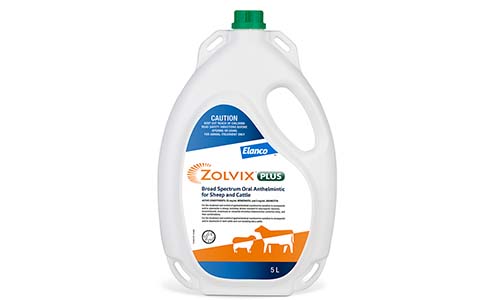Leading animal health company, Elanco, has announced that Zolvix Plus – a broad spectrum drench used in the sheep industry – is now registered for use in beef and non-lactating dairy cattle.

Zolvix Plus is a unique combination drench that contains 25 g/L monepantel and 2 g/L abamectin.
Monepantel belongs to the amino-acetonitrile derivative – or ‘orange’ – family of anthelmintics, the first new broad spectrum drench class to be registered for use in cattle in Australia for nearly 40 years.
Elanco Brand Manager, Dave Rathbone, said the registration is exciting news for beef and dairy producers.
“Zolvix Plus contains Monepantel, representing the only member of the first new broad spectrum drench class for cattle to be introduced to Australia since the ‘mectins’ were introduced in the mid-80s,” he said.1
“Producers have access to dozens of broad-spectrum drenches, but they all belong to three chemical groups.
“Resistance to all three of these groups has been reported in all major worm species in Australia.2-4
“Put simply, it’s time for beef and dairy producers to incorporate new and fully-effective chemistry into their drenching program.”
Zolvix Plus is registered for the control of all of the most important worm species found in young cattle5, including Haemonchus, Ostertagia, Cooperia and Oesophagostomum (adult only).
Dose determination and dose confirmation studies have shown Zolvix Plus provides greater than 98 per cent (pc) efficacy against all major worm species, while Australian field trials demonstrated 99.9 pc efficacy.6,7
“This proven efficacy means Zolvix Plus will be particularly suitable for use in worm control programs in young cattle, which are more susceptible to parasite burdens,” Dave said.
“Zolvix Plus is also ideal for use in ‘quarantine’ drenching programs.
“Best practice guidelines recommend treating all introduced cattle using a drench that contains as many unrelated active ingredients as possible to prevent any worms, particularly resistant strains, from being introduced to the property.”8
Zolvix Plus will also have a role to play in maintaining the efficacy of older active ingredients.
“Monepantel and abamectin are both broad spectrum drenches with different modes of action, so they are ideal combination partners,” Dave said.
“The use of drenches containing two or more active ingredients can maximise efficacy and help to prolong the life of all available chemistry.”9
Zolvix Plus is administered orally at a dose of 1 mL/10 kg body weight using the Zolvix Plus 30 mL Cattle Oral Drencher.
It can be administered to beef and dairy calves more than 100 kg liveweight or at least 16 weeks of age.
Zolvix Plus has a Meat Withholding Period of 12 days and an Export Slaughter Interval of 61 days when used in beef and dairy cattle.
Do not use in lactating cows or within 49 days of calving where milk may be used or processed for human consumption. The minimum re-treatment interval is 21 days.
After three consecutive treatments, 61 days must elapse before treating again. Always read and follow label directions. Good agricultural practice is essential for optimal worm control.
This article was written by Elanco for Seasons magazine.
Disclaimer – Important, please read:
The information contained in this article is given for general information purposes only, current at the time of first publication, and does not constitute professional advice. The article has been independently created by a human author using some degree of creativity through consultation with various third-party sources. Third party information has been sourced from means which Elders consider to be reliable. However, Elders has not independently verified the information and cannot guarantee its accuracy. Links or references to third party sources are provided for convenience only and do not constitute endorsement of material by third parties or any associated product or service offering. While Elders has exercised reasonable care, skill and diligence in preparation of this article, many factors including environmental/seasonal factors and market conditions can impact its accuracy and currency. The information should not be relied upon under any circumstances and, to the extent permitted by law, Elders disclaim liability for any loss or damage arising out of any reliance upon the information contained in this article. If you would like to speak to someone for tailored advice specific to your circumstances relating to any of the matters referred to in this article, please contact Elders.
References:
- Gilleard, J., et al. (2021). A journey through 50 years of research relevant to the control of gastrointestinal nematodes in ruminant livestock and thoughts on future directions. Int J Parasitol 51:1133–1151.
- Allworth, B. et al. (2023). Comparison of the efficacy of macrocyclic lactone anthelmintics, either singly or in combination with other anthelmintic(s), in nine beef herds in southern NSW. Aust Vet J 101(8):293-295.
- Bullen, S. et al. (2016). Anthelmintic resistance in gastrointestinal nematodes of dairy cattle in the Macalister Irrigation District of Victoria. Aust Vet J 94(1-2):35-41.
- Wonders, N (2016). What does anthelmintic resistance mean for worm treatment in cattle? Proceedings of the Australian Cattle Veterinarians Conference, Ayers Rock, Northern Territory, 129-130.
- Wormboss website - roundworms
- Elanco data on file (YAR-13-028, YAR-13-042, NAH-14-207, NAH-15-369 & YAR-13-041).
- Elanco data on file (NAH-13-039, NAH-13-040, NAH-13-041 & NAH-13-042).
- Wormboss.com.au - quarantine-drenching
- Wormboss website - combination drenches
